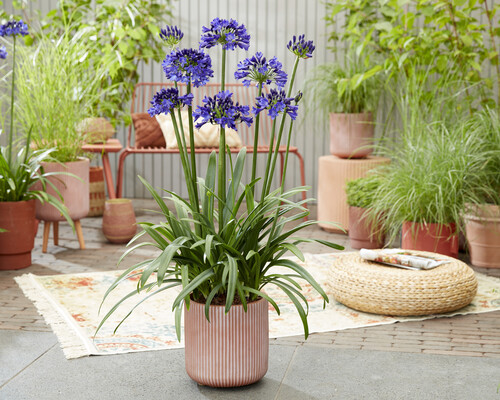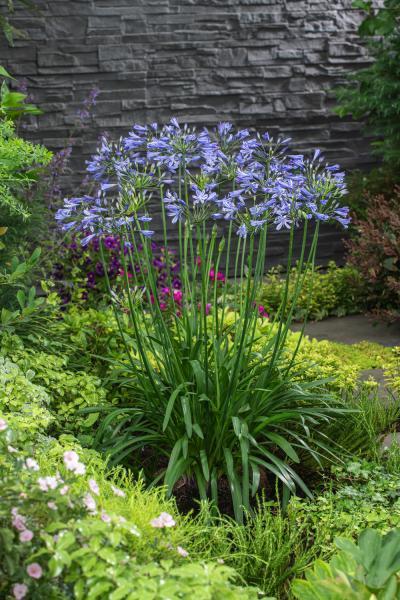Mastering the Art of Agapanthus Treatment: Essential Actions for Healthy And Balanced Growth and Vivid Blossoms
In the realm of cultivation, the growing of agapanthus stands as a fulfilling venture for those that seek to support these classy flowering plants. From picking the right range to understanding pruning methods, the trip towards growing growing agapanthus plants is multifaceted and holds the crucial to opening the full capacity of these organic treasures.

Picking the Right Agapanthus Variety

When picking the ideal Agapanthus variety for your yard, think about factors such as environment suitability, blossom color, and growth habit. Additionally, take into consideration the climate in your area to make certain the Agapanthus selection you choose can grow in your specific problems. Comprehending the development habit of different Agapanthus ranges is essential for correct positioning within your garden.
Perfect Planting Problems
Thinking about the optimum environmental demands is essential for successful Agapanthus farming. Agapanthus plants are delicate to cold temperature levels and need to be secured from frost during winter season months.
To make sure healthy and balanced growth and dynamic flowers, plant Agapanthus light bulbs at a deepness of about 2-4 inches and space them 8-12 inches apart. Adding raw material, such as garden compost, to the dirt can improve drainage and fertility, promoting robust root advancement. Mulching around the base of the plants aids preserve dampness and suppresses weed growth. Regular watering is important, specifically throughout the expanding period, to maintain the dirt continually moist but not waterlogged.
Watering and Fertilizing Tips
Preserving appropriate dampness degrees and supplying necessary nutrients are key aspects in the treatment regimen for Agapanthus plants. When it comes to watering Agapanthus, it is essential to strike an equilibrium. These plants like regularly wet dirt but are at risk to root rot if overwatered.
Fertilizing Agapanthus is necessary for advertising healthy development and respected blooms. Apply a well balanced plant food, such as a 10-10-10 formula, in the early spring as brand-new development arises. By adhering to these watering and fertilizing suggestions, you can guarantee your Agapanthus plants thrive and create vivid, long-lasting flowers.
Trimming Strategies for Agapanthus
Pruning Agapanthus plants at the proper times and with correct techniques is important for keeping their health and promoting ideal development and blooming. The ideal time to prune Agapanthus is in late wintertime or very early springtime before new development arises. Beginning by removing any yellowing or dead fallen leaves near the base of the plant. Cut them as short as feasible without damaging the emerging shoots.
Deadheading invested flowers can additionally reroute the plant's energy into producing even more blossoms instead than establishing seeds. If you desire to gather seeds for propagation, leave some flowers to dry and fully grown on the plant.
Keep in mind to utilize look at this site tidy, sharp tools to make precise cuts and lower the risk of presenting diseases. Agapanthus. Normal trimming will certainly help maintain your Agapanthus looking healthy and balanced and cool while guaranteeing a bountiful screen of stunning blooms
Managing Typical Insects and Conditions
After ensuring appropriate trimming techniques for Agapanthus, it is crucial to deal with usual insects and conditions that can influence the wellness and vitality of these plants. One usual insect that influences Agapanthus is the Agapanthus gall midge.
One more usual issue is fungal fallen leave place, which presents as dark sores on the fallen leaves. To avoid fungal illness, ensure great air flow around the plants, stay clear of overhead watering, and eliminate any kind of More Bonuses infected leaves immediately. In addition, Agapanthus plants can deal with root rot if they are grown in poorly draining dirt. To stop this, plant Agapanthus in well-draining soil and avoid overwatering. By being attentive and taking punctual action against insects and illness, you can assist your Agapanthus plants grow and generate vibrant blooms.

Verdict
Finally, mastering the art of agapanthus treatment involves selecting the right variety, offering suitable growing problems, appropriate Related Site watering and feeding, proper trimming methods, and dealing with common pests and conditions. By adhering to these necessary steps, you can ensure healthy and balanced growth and vibrant blossoms for your agapanthus plants. Bear in mind to consistently keep an eye on and maintain your plants to advertise their general well-being and long life.
To make sure healthy development and lively blooms, plant Agapanthus light bulbs at a depth of concerning 2-4 inches and area them 8-12 inches apart. By following these watering and feeding suggestions, you can guarantee your Agapanthus plants prosper and produce vivid, resilient blooms.
One typical insect that influences Agapanthus is the Agapanthus gall midge. In addition, Agapanthus plants can experience from origin rot if they are planted in inadequately draining dirt. By complying with these essential steps, you can make sure healthy development and vibrant flowers for your agapanthus plants.
Comments on “Agapanthus Treatment Tips for Lush and Vibrant Flowers”